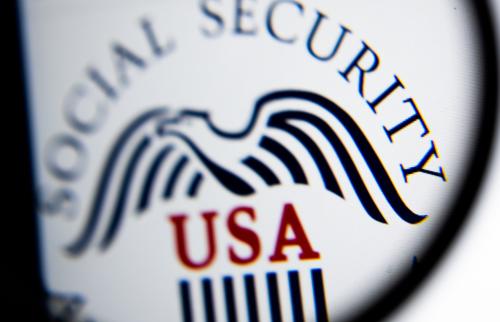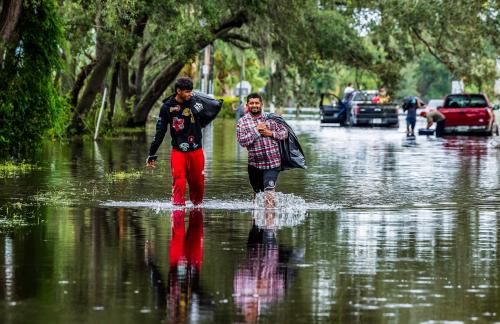April 30 marks 100 days since President Trump took office for the second time. In a short span, the administration has shifted nearly every aspect of immigration policy in the anti-immigrant direction: furthering the 2024 decline in humanitarian and unauthorized flows, constricting regular immigration pathways, boosting enforcement, and making life harder for immigrants living in the U.S. The effort is seemingly aimed at reducing the number of immigrants in the U.S. overall, regardless of legal status or criminal history, and increasing fear and uncertainty among those who remain. The actions have been marked by disregard for process. Here we take a look at the major developments.
Inflows: substantially down at the border, and sand in the gears throughout the system
During the Biden administration, there were large and unexpected immigration flows at the southern border. The surge was dominated by those who lacked regular status but were allowed to enter for humanitarian reasons, including asylum seekers with a credible fear of returning home, participants in humanitarian parole programs for those fleeing from certain countries, and individuals who received temporary parole or a notice to appear in immigration court. The Congressional Budget Office estimated overall net migration of 3.3 million in 2023, including migration of “other foreign nationals” far higher than historical norms (see Figure 1). However, border flows dramatically declined in 2024.
Figure 2 shows the number of “inadmissible” people—those encountered by Customs and Border Protection (CBP) at or between ports of entry who lack a regular visa—and “likely entries”—a subgroup of inadmissible encounters who receive a parole status or notice to appear in immigration court. During 2024, the Biden administration worked with Mexico and other countries to reduce border flows, and it implemented temporary provisions in June 2024 making it more difficult to have asylum claims considered.
Border flows have continued to fall in early 2025, with authorities allowing almost no humanitarian migrants to cross the border, as can be seen in the most recent bars in Figure 2. An important tool for humanitarian migrants to seek entry during the Biden administration was through a newly created CBP app called CBP One. This app enabled asylum-seekers and other humanitarian migrants to make an appointment at a port of entry for consideration of a credible fear claim. The second Trump administration ended the use of the app. In addition to foreclosing new CBP One appointments, approximately 30,000 people saw their existing appointments abruptly canceled, some of whom had made arduous journeys to reach the border. CBP recently released CBP Home, where “[a]liens can now notify the U.S. Government of their intent to depart the United States.”
Trump also shuttered humanitarian programs like the Processes for Cubans, Haitians, Nicaraguans, and Venezuelans (CHNV) which had created an orderly, temporary pathway for those leaving Cuba, Haiti, Nicaragua, and Venezuela to enter the U.S. (The administration’s plan to prematurely terminate protection for the approximately 530,000 people who had previously entered the U.S. under CHNV was halted by the courts in April.)
These changes virtually eliminate all opportunities for immigrants to enter the U.S. seeking asylum. Many observers argue that the asylum system had outstripped its intended use under Biden, exacerbating backlogs in the immigration court system and fueling more border traffic. However, the U.S. does have an obligation under Article 14 of the UN Universal Declaration of Human Rights to consider asylum claims.
Humanitarian migration through the formal international refugee program has also been halted. In January, President Trump issued an Executive Order suspending the refugee program. A circuit court recently ruled that admission should be allowed for the roughly 10,000 people who had already been vetted and had their flights canceled, but the suspension of federal funding supporting refugee integration efforts in the U.S. may make that difficult. The suspension marks a break with a decades-long U.S. commitment to admitting refugees; the U.S. has admitted an average of about 73,000 refugees annually between 1975 and 2024. Despite the moratorium on refugee admissions, the administration has signaled its intent to consider refugee status for white South Africans.
Surreptitious border crossings—also known as “entries without inspection”—are inherently difficult to measure, but these likely declined in 2025 as well. The long-standing staffing challenges in Border Patrol make a rapid expansion of personnel difficult, and instead presence at the southern border has been bolstered by nearly 7,000 military troops and deputized members of state National Guards. The Department of Interior is also transferring about 110,000 acres of border land to the military for a period of three years to strengthen border enforcement. Despite bolstered border enforcement, encounters between agents and migrants between ports of entry have fallen (see Figure 3), suggesting fewer attempted crossings.
There is also a regular migration system. Congress, not the executive branch, sets the numerical limits on most forms of legal permanent resident (LPR) migration and temporary employment migration. The legal system is mostly governed by laws last updated in 1990, which, as we have argued elsewhere, are far too low, with significant economic costs. The low limits and strict criteria set by Congress mean there are virtually no legal pathways for most would-be migrants worldwide.
The administration can put sand in the gears of this system to further weaken the ability of immigrants to come and stay, even without a change to the LPR numerical caps. For example, the administration has cut staff in its office of U.S. Citizenship and Immigration Services (USCIS), which will almost certainly exacerbate existing backlogs in processing. USCIS also updated a number of forms to eliminate a non-binary gender option, and has since been sued for failing to provide notice or a grace period. The agency recently registered its intent to request social media handles on a variety of immigration forms including the application for citizenship, and stated that social media activity will be screened for activity it views as antisemitic. It has also required “extreme vetting” for some travelers and immigrants, a move which threatens to delay the normal issuance of visas and green cards. All of these measures are attempts by the administration to make navigating the U.S. immigration system more difficult.
U.S. businesses also rely heavily on temporary workers arriving through a range of programs like the H-1 and H-2 programs. For example, the H-1B is a capped program mainly used for tech workers, and the H-2A is an uncapped program for agricultural workers. Project 2025, a policy blueprint for the administration spearheaded by the Heritage Foundation, calls for rule changes that would dramatically reduce the number of H-1 and H-2 temporary visas issued even without Congressional action. Though Trump has taken administrative steps to curtail employment programs in the past, there is current debate within the administration about whether and how to make changes, and their fate remains to be seen.
Higher education is another area of uncertainty. The sector represents $56 billion annually in services to international students. Many universities rely on those students to bolster tuition revenue, indirectly boosting educational opportunity for U.S.-born students. Project 2025 advocated the withholding of student visas from a number of countries including China, but this has not yet occurred. However, the administration did abruptly revoke over 1,800 student visas since January before reversing course in late April, at least temporarily. It recently threatened to deny Harvard the ability to sponsor international students. High-profile cases such as the videotaped street apprehension of Rümeysa Öztürk may dissuade students from choosing the U.S. for college or graduate school. More generally, the contraction of federally-supported research and sudden revocations of student visas will likely lead to fewer students and other researchers coming to the U.S. to do their work. As of February 2025, the number of student visas issued did not yet seem to be adversely affected (see Figure 4).
Interior enforcement: more arrests, less due process, but not yet more deportations
During the first Trump administration, immigration arrests increased, particularly of non-criminals. However, because many of those snared in the wider net had no criminal history, they had stronger cases for relief, and the arrests did not always lead to deportation. In the end, deportations in the first Trump term remained below first-term Obama levels. With Trump’s campaign promises of mass deportation in the lead up to the 2024 election, there was little doubt enforcement activity would be a priority in the new administration.
To that end, the administration has tripled the number of agreements with local law enforcement agencies, deputizing them to carry out some immigration activities normally in federal purview. So-called “task force” agreements allow officers to conduct enforcement activities during routine policing, an approach the Department of Justice and researchers have previously found to lead to racial profiling.
Indeed, as seen in Figure 5, the monthly number of ICE-initiated arrests—which are primarily the result of interior rather than border enforcement—has more than doubled. Detention is also higher, though constrained by the number of beds currently available (Figure 6). The administration has recently taken steps to expand contracts with for-profit prisons in an effort to more than double the number of immigration detention beds, at a projected cost of $45 billion.
Alongside the increased enforcement and detention capacity, the administration is taking steps to cancel some programs protecting individuals from deportation. The courts have prevented some of these actions, such as the premature termination of Temporary Protected Status (TPS) for several hundred thousand Venezuelans. But as TPS protections and individually issued paroles expire on their expected schedule, many immigrants will lose their temporary status and associated work permits. For example, the administration does not intend to extend TPS for Afghans which is set to expire this May. Some Afghan immigrants who had been granted temporary protection in response to the turmoil of U.S. withdrawal and Taliban rule are in the bureaucratic process of obtaining a more permanent status and will be at risk of deportation.
The administration has defied long-standing practices and laws in its enforcement approach. Here are some examples:
- Revoking sensitive locations guidance, which had previously hindered immigration enforcement activity in sensitive locations like schools, hospitals, and churches.
- Using a broad array of agencies to enforce immigration laws, including by reassigning personnel away from their core functions such as a reported 25% of the Drug Enforcement Agency and 80% of Alcohol, Tobacco, and Firearms agents. Agency data collected for other purposes is also being newly exploited, including a memorandum of understanding to use Internal Revenue Service data collected when unauthorized immigrants file taxes. Also, about 6,000 immigrants with valid Social Security numbers had their status abruptly revoked and were then recorded in the death file maintained by the Social Security Administration.
- Invoking the Alien Enemies Act, a war power infamously used to justify internment of Japanese-Americans during World War II. In March, the act was used to justify deporting alleged gang members to a brutal prison in El Salvador without a court hearing, a case that continues to dominate headlines.
- Revoking visas and arresting certain individuals apparently because of political speech. Examples include pro-Palestinian activist Mahmoud Khalil, a green card holder; Georgetown international scholar Badan Khan Suri; and Tufts student Rümeysa Öztürk. High-profile cases like these chill free speech.
- Requiring registry of all immigrants ages 14 and older who have been in the country more than thirty days, for the stated purpose of facilitating enforcement and encouraging voluntary exits.
- Three reported cases of U.S. citizen children, including one in cancer treatment, being removed from the country when their mothers were deported.
The extraordinary actions of the Trump administration are being contested through the courts with mixed results. Regardless of the legal outcomes, the administration has successfully created a climate of fear among undocumented residents, international students, and even legal permanent residents. This climate has also impacted travel to the U.S., with a reported 12% decline in arrivals from countries other than Canada and Mexico compared to the same time last year.
One area where the administration appears to be failing to meet its enforcement goals is in the number of deportations. Deportation statistics include both people turned away at the border and removals of unauthorized residents from the interior of the U.S. The lull in border activity could lead to fewer deportations, even if more long-standing residents are being deported. The best available evidence indicates that total daily removals remain below Biden-era levels, and the administration is reportedly disappointed by the numbers. However, the Department of Homeland Security has not updated the public data on removals since December, so the actual number of deportations overall and deportations from the interior is unclear.
We are not surprised that deportations have remained muted despite the administration’s efforts. It takes time to arrest and detain people, and most immigrants have a right to a court hearing before removal. In some cases, diplomatic engagement with countries of origin or third countries is needed. There are also non-trivial resources required for the operations and logistics of removal. The effects of scaled-up enforcement on deportation numbers could take months or years to materialize.
At the same time, building state capacity to enforce immigration law through the courts does not seem to be a priority for the administration. Expanding the number of judges would help to reduce the immigration court backlogs and to pave the way for more deportations, given that historically about half of cases result in an order of removal. The current backlog exceeds 3 million cases (see Figure 7), but the administration has cut back on the number of judges who are available to adjudicate these cases.
Instead, the administration appears to be trying to avoid due process requirements altogether, with Trump stating that “[w]e cannot give everyone a trial, because to do so would take, without exaggeration, 200 years.” The invocation of the Alien Enemies Act to circumvent due process is legally contested. Making the environment inhospitable for immigrants may accelerate “self-deportation,” another stated goal which also dispenses with the need for legal process.
The suite of changes underway affects not just those directly impacted but all immigrant communities. Well-known chilling effects are likely to inhibit undocumented immigrants from sending their children to school, seeking health care, and reporting crimes. Immigrants, including those with legal status, report concern about travel and expressing political opinions in public. With the change in sensitive locations guidance, religious communities are likely to be affected as well. (For example, a report from the National Association of Evangelicals estimates that 1 in 12 Christians in the U.S. is vulnerable to deportation or lives with a family member who could be deported.)
The downstream impacts are not limited to immigrants. About 5.62 million U.S.-born children live with at least one undocumented household member, and 2.66 million children only have undocumented parents in the home. While most children will be cared for by relatives or friends in the event their parent is arrested or detained, some will end up in much worse situations. As we have explored previously, the child welfare system is neither required nor well-equipped to handle a large influx of American children who are separated from their parents due to immigration enforcement.
Additional extraordinary measures
Immigration policy is a key area where the current administration is testing the limits of its consolidation of power. The case of deportations to El Salvador is one example. The administration invoked the Alien Enemies Act in secret, put over 200 men, mostly Venezuelan, on a plane before a court could intervene, and failed to turn the plane around despite court instructions to do so. In a related case, a unanimous Supreme Court ruling required that the government “facilitate” the return of an El Salvadoran man, Kilmar Abrego Garcia, who was mistakenly removed to El Salvador in defiance of a court order. The circumvention of the normal due process rules that apply to undocumented immigrants is potentially a first step towards a broader weakening of rights. Indeed, the administration has suggested it might want to relocate U.S. citizens to the same notorious El Salvadoran prison. As Reagan-appointed judge Harvie Wilkinson described in a ruling:
“The government is asserting a right to stash away residents of this country in foreign prisons without the semblance of due process that is the foundation of our constitutional order. Further, it claims in essence that because it has rid itself of custody that there is nothing that can be done. This should be shocking not only to judges but to the intuitive sense of liberty that Americans far removed from courthouses still hold dear.”
Another example of potential misuse of power is the alleged quid pro quo in which the Department of Justice dropped bribery charges New York mayor Eric Adams after he offered to collaborate with the administration on immigration enforcement efforts.
President Trump also issued an executive order which would restrict birthright citizenship, clearly at odds with the 14th Amendment to the Constitution. Though highly unlikely to survive U.S. Supreme Court review, the order signals a clear intent to take immigration policy further into unprecedented territory. A Supreme Court hearing as to whether the existing injunction against the changes to birthright citizenship can be paused is expected in May. A different executive order deemed English the official language of the country.
Garnering less media attention, but also concerning, are reductions in transparency and accuracy of data. For instance, the Department of Homeland Security is reporting implausible numbers of deportations on press calls, but its statistical dashboard is not showing the recent data. Monthly data on immigrant work permits is also stalled.
What does it all mean?
In the short run, the administration has radically changed the U.S. approach to immigration. It has not simply ramped up enforcement efforts; it has expanded the enforcement apparatus in unexpected ways and in some cases ignored due process protections. Importantly, the aggressive approach extends to those with legal status and those without criminal histories, leading to an environment in which any non-citizen is a target. The numbers of deportations remain modest, but the chilling effects are potentially severe.
We have argued elsewhere that the high levels of immigration boosted labor force growth and aided in the post-COVID-19 economic recovery. The significant decline in net immigration flows which will occur this year, possibly yielding net negative migration for the first time in decades, will reduce GDP growth and could contribute to a recession. Certain immigrant-dependent industries like agriculture, construction, and services may see labor shortages. Slowing immigration also adds to concerns about the Social Security Trust Fund which is expected to be exhausted in 2035.
For decades, Congress has shown an unwillingness to build consensus or modernize the immigration system, leaving too much power in the hands of the executive branch. Until now, however, this long-standing policy failure did not prevent the U.S. from being the leading immigrant destination in the world. Economists have long lauded immigration as a contributor to economic growth and dynamism, and immigration is the main reason the U.S. continues to have population growth. Social mobility of immigrants is in evidence today as much as it was in the early 20th century. And the U.S. reputation as the premier destination for global talent has fueled innovation, entrepreneurship, and—arguably—American economic primacy.
The authoritarian excesses in the immigration sphere—where they tend to be more politically popular—may well bleed into other areas. In this way, immigration could foreshadow a significant reshaping of American civics and democracy. For now, the courts continue to provide a meaningful check on executive authority, though the administration has shown a willingness to sidestep or even ignore court orders.
Beyond legal constraints, the political landscape is a critical determinant of what comes next. Congress has continued their decades-long pattern of abdicating responsibility on immigration issues, emerging only to pass a bill mandating detention of immigrants accused of low-level crimes. Americans, including 9 in 10 Republicans and nearly half of Democrats, expressed support for mass deportation in January. But, as was seen with outrage over family separation in 2018, the realities of enforcement are far less politically popular. Polling suggests continued approval of tight border policy, but recently, more Americans oppose than support Trump’s immigration enforcement approach (see late April polls here, here and here).
Even if the current extraordinary moment is short-lived, the impacts on immigration may linger. It is already clear to immigrants around the world that official promises can be removed with the stroke of a pen and that the worst-case scenario could include being sent to an El Salvadoran prison. A sufficiently hostile administration has the power to make Canada, Europe, or China the new destination of choice, creating new economic powerhouses and squandering the current U.S. advantage in the global competition for people and talent. There is no guarantee that Reagan’s “city on the hill” remains in America.
The Brookings Institution is committed to quality, independence, and impact.
We are supported by a diverse array of funders. In line with our values and policies, each Brookings publication represents the sole views of its author(s).








Commentary
100 Days of immigration under the second Trump administration
April 29, 2025